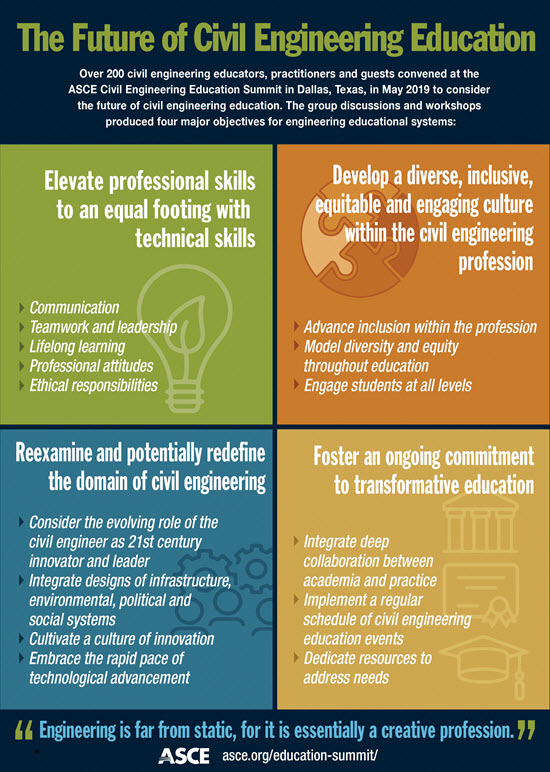ASCE Releases Roadmap For The Future Of Civil Engineering Education
The 2019 ASCE Education Summit, held in Dallas last May, included a mission statement of sorts as its subtitle: “Mapping the Future of Civil Engineering Education.”
A year later, ASCE has released that map.
The full report of summit findings is available as a free download on the ASCE website.
Included in the report are four key recommendations that provide a structure of aspirations for civil engineering education:
- Elevate professional skills to an equal footing with technical skills.
- Develop a diverse, inclusive, equitable and engaging culture within the civil engineering profession.
- Reexamine and potentially redefine the domain of civil engineering.
- Foster an ongoing commitment to transformative education.
“We need to, as educators, incorporate this into the curriculum but also articulate why the students need this knowledge, why these changes are happening and why they should continue to happen into the future,” said Audra Morse, Ph.D., P.E., F.ASCE, chair of the civil and environmental engineering department at Michigan Tech.
“I really like that the report starts out by saying ‘Engineering is not static.’ The profession is not static. Their careers will not be static. So the knowledge that they need is not going to be static.”
More than 200 civil engineering educators, practitioners and guests convened at the ASCE Civil Engineering Education Summit in Dallas, May 2019, for group discussions and workshops surrounding the future of civil engineering education. Now that the report has been released, a newly formed Civil Engineering Education Summit working group is refining and further developing the objectives outlined in the report into actions for ASCE to take.
“It gives people time to meet with industry, to meet with academia, and say, ‘OK, what do we see? Let’s look beyond tomorrow. Let’s look well into the future. What do we see as trends? What do we see as the needs both from industry as well as what students are demanding?’” said Scott Hamilton, Ph.D., P.E., F.ASCE, chair of ASCE’s Committee on Education and chair of the civil and mechanical engineering department at York College of Pennsylvania.
“Because the majority of civil engineering majors are going to go out and practice, and being able to prepare them is job number one for us.”

It was the first such ASCE conference since 1995’s Civil Engineering Education Conference. And a quarter-century is a long time in any industry, but the last particular quarter-century feels particularly momentous in terms of change in this particular industry.
The summit report’s recommended objective to potentially redefine the domain of civil engineering feels especially necessary and powerful, Hamilton and Morse agreed.
“So many things have happened since 1995, new things that were never even considered civil engineering then and now are,” Hamilton said. “We’re looking at the role of data analytics now. No one was really doing that then. We know AI is coming forward. How is that going to impact buildings? The whole idea of the Internet of Things. How do we integrate all of this?
“It changes the way we can operate and should operate. And it means that as a profession we have to keep up.”
COVID-19 has changed the world even further in the 13 months since the 2019 Education Summit. Morse said she thinks the current events of 2020 have only reinforced the summit findings.
“Our world has been shaken up, and there’s good that can come from that shakeup,” Morse said. “It will be interesting to see how we rethink infrastructure, how we move people, how we plan things like stadiums.
“I think the civil engineering profession has to respond and learn and do better. Which is really what this document is all about.”
Source: ASCE
